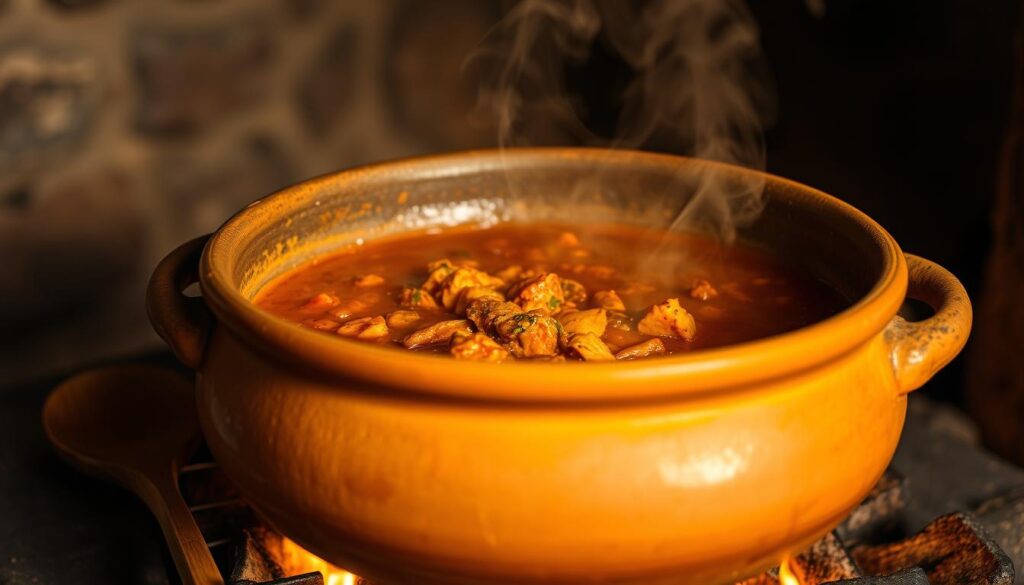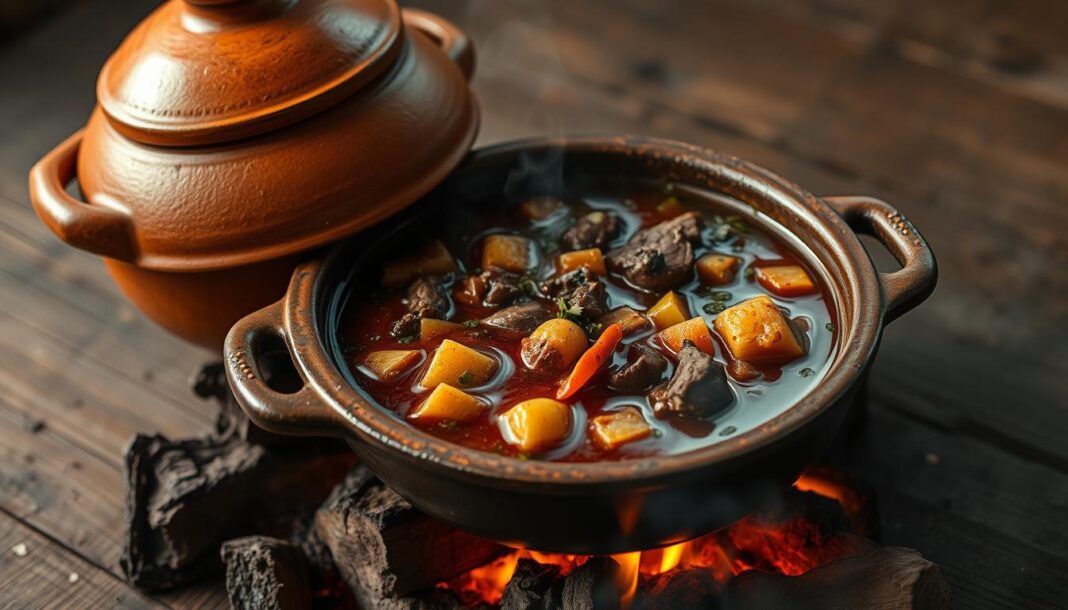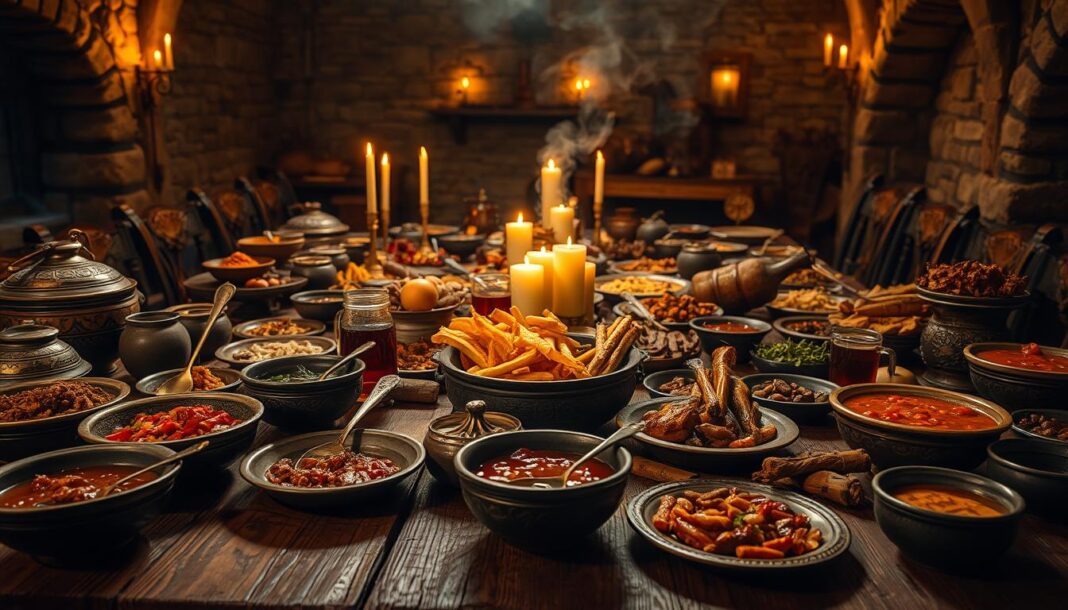Olla stew, a hearty dish with deep cultural roots, has been a staple in various cuisines for generations. The traditional earthenware pot, or “olla,” used in its preparation, plays a crucial role in the slow-cooking process that defines this flavor-rich meal.
At Historical Foods, we explore the fascinating culinary tradition behind this beloved stew, examining how different regional variations share common cooking principles while showcasing unique local ingredients and techniques. By understanding the science behind the slow cooking process and the role of meat and vegetables in creating the distinctive depth of flavor, you’ll be able to master the time-honored techniques that transform simple ingredients into complex, satisfying meals.
Our comprehensive guide will walk you through the essential components of recipe development, helping you create authentic versions of this comfort food at home, appreciating the time-tested methods that make olla stew a cherished tradition across cultures.
What Makes Olla Stew Unique
The uniqueness of olla stew lies in its ability to adapt to various cultural contexts while maintaining its core characteristics. This adaptability is a testament to the dish’s rich history and its significance in different culinary traditions.
Origins and Cultural Significance
Olla stew has its roots in traditional cooking methods, where meat and vegetables were slow-cooked together to create a nourishing dish. The cultural significance of olla stew is evident in its presence at family gatherings and communal meals across various cultures. For instance, in Costa Rica, Olla de Carne is a beloved recipe that features beef, typically short ribs, cooked with native vegetables like chayote, yuca, and corn, resulting in a light yet flavorful broth.
Regional Variations: From Costa Rica to Spain
Regional variations of olla stew showcase its versatility. In Spain, Olla Podrida, meaning “powerful pot,” combines various meats (pork, beef, chicken) with chickpeas or beans and regional vegetables, reflecting the country’s diverse culinary landscape. Mexican versions often incorporate dried chiles and indigenous vegetables, creating distinctive flavors. The table below highlights some key differences in olla stew recipes across regions.
| Region | Main Ingredients | Notable Characteristics |
|---|---|---|
| Costa Rica | Beef (short ribs), chayote, yuca, corn | Light, flavorful broth |
| Spain | Pork, beef, chicken, chickpeas, regional vegetables | Diverse, hearty |
| Mexico | Various meats, dried chiles, indigenous vegetables | Distinctive, bold flavors |
These variations demonstrate the adaptability of olla stew recipes across different climates and cultural preferences, making it a truly unique and versatile dish.
The Science of Slow Cooking in Olla Stew
The science behind slow cooking in olla stew reveals the secrets to transforming tough cuts of meat into tender delicacies. This traditional cooking method involves a complex interplay of heat, time, and ingredient quality, resulting in a richly flavored and textured dish. As we delve into the science of slow cooking, we will explore the key factors that contribute to the tenderization of meat and the development of flavors.
Heat Transfer and Collagen Breakdown
Heat transfer plays a crucial role in the slow cooking process. As heat penetrates the meat, it breaks down collagen, a protein that makes meat tough. This breakdown results in tender, fall-apart texture. The slow cooking process allows for even heat distribution, ensuring that the meat is cooked consistently throughout.
Flavor Development Through Maillard Reaction
The Maillard reaction is a chemical reaction between amino acids and reducing sugars that occurs when food is cooked, leading to the formation of new flavor compounds. In olla stew, this reaction enhances the flavors of the ingredients, creating a rich, complex taste experience. The slow cooking process, with its low heat and long cooking times, is ideal for inducing the Maillard reaction.

The Role of Time in Tenderizing Tough Cuts
Time is a critical factor in tenderizing tough cuts of meat. The extended cooking times used in olla stew allow for the gradual breakdown of connective tissues, making the meat tender and succulent. Different cooking methods, such as slow cooking or pressure cooking, affect the time required to achieve optimal tenderness.
| Cooking Method | Tenderization Time | Characteristics |
|---|---|---|
| Slow Cooker | 6-8 hours | Low heat, moist environment |
| Pressure Cooker | 1-2 hours | High pressure, rapid cooking |
| Traditional Stovetop | 2-3 hours | Variable heat, requires monitoring |
Essential Ingredients for Authentic Olla Stew
The foundation of a rich and flavorful olla stew lies in its ingredients. To create an authentic version of this beloved dish, it’s crucial to understand the role of each component. We will explore the key ingredients that make olla stew a hearty and satisfying meal.
Selecting the Right Meat Cuts
Choosing the appropriate meat cuts is vital for the success of olla stew. Beef is a traditional choice, with tougher cuts like brisket or shank being ideal due to their rich flavor and tenderizing effect during slow cooking. The slow cooking process breaks down the connective tissues in the meat, making it tender and flavorful.
Some recipes also incorporate other meat types, such as pork or lamb, to add depth to the stew. The key is to select cuts that benefit from long cooking times, ensuring they become tender and infused with the flavors of the other ingredients.
Vegetable Combinations and Their Purpose
The vegetables used in olla stew not only add flavor but also texture and nutrients. Common vegetables include potatoes, carrots, and onion, which are staples in many variations. Garlic is another essential ingredient, often sautéed at the beginning to create a flavorful base.
Other vegetables like beans, chickpeas, and squash may be added to enhance the stew’s heartiness and nutritional value. The combination of these ingredients creates a balanced and satisfying meal. For example, beans and chickpeas add protein, while potatoes and carrots provide complex carbohydrates.
Some recipes may also include tomatoes for an acidic contrast to the rich meat and vegetables. The variety of vegetables used can vary significantly by region, reflecting local preferences and ingredient availability.
Traditional Herbs and Spices
The flavor profile of olla stew is significantly influenced by the herbs and spices used. Salt is a crucial seasoning, used to enhance the natural flavors of the ingredients. The timing of salt addition can affect the overall flavor, with some cooks preferring to add it early to allow the flavors to meld together.
Regional variations in herbs and spices are notable, with Latin American versions often featuring cilantro and mint, while European recipes might use bay leaves and thyme. Understanding how different herbs respond to heat is key to using them effectively—woody herbs are typically added early, while delicate ones are added towards the end of cooking.
The use of garlic at different stages can also vary its impact, from sharp when raw to sweet when sautéed, or deep and mellow when cooked for an extended period. Whole spices are often preferred over ground ones for more controlled flavor development.
A well-balanced olla stew recipe achieves a harmony between acidic elements, like tomatoes, and earthy components, creating a complex and engaging flavor profile. Regional spice variations, such as Spanish paprika or dried chiles, reflect cultural influences and add to the stew’s unique character.
Traditional Cooking Methods for Perfect Olla Stew
Olla stew’s rich flavor profile is largely due to time-honored cooking practices. We will explore the traditional cooking methods that make olla stew a beloved dish across various cultures.
Pressure Cooker vs. Slow Cooker Techniques
When it comes to cooking olla stew, the choice between a pressure cooker and a slow cooker depends on the desired outcome and time available. Using a pressure cooker can significantly reduce cooking time to under an hour, while a slow cooker allows for a more gradual development of flavors over several hours. For instance, cooking on low heat for 3 hours can tenderize tough cuts of meat, making them palatable.
For those using a pressure cooker, it’s essential to monitor the cooking time carefully. Typically, 30 minutes of cooking under pressure is sufficient for tenderizing the meat. On the other hand, slow cookers require a longer duration, often 6-8 hours, but the result is a rich, flavorful stew.
The Two-Pot Method: Separating Meat and Vegetables
The two-pot method involves cooking the meat and vegetables separately before combining them. This technique allows for better control over the cooking process and can result in a clearer broth. To achieve this, we can cook the meat in one pot with some oil and cloves garlic for added flavor, while the vegetables are cooked in another with water and a selection of herbs.
By separating the ingredients, we can ensure that each component is cooked to perfection. For example, delicate vegetables can be cooked for 20-30 minutes, while tougher meat cuts may require an hour or more.
Achieving the Ideal Broth Consistency
Achieving the ideal broth consistency is crucial for a satisfying olla stew. The key is to balance the water content and cooking time. Skimming foam during the initial 30 minutes of cooking helps ensure a clear broth. Additionally, using starchy vegetables like potatoes can naturally thicken the broth as they break down.
| Cooking Method | Cooking Time | Broth Consistency |
|---|---|---|
| Pressure Cooker | 30 minutes | Thick |
| Slow Cooker | 6-8 hours | Rich and Flavorful |
| Two-Pot Method | Varies | Clear |
For more detailed olla stew recipes, you can explore various resources online that provide step-by-step instructions and variations on traditional methods.
Serving and Enjoying Your Olla Stew Creation
The art of crafting the perfect Olla Stew is a nuanced process that blends tradition with science. As we bring our Olla Stew to the table, the way we choose to serve it can elevate the dining experience, highlighting the dish’s rich flavors and cultural significance.
Traditional serving methods showcase the stew’s vibrant components in large, shallow bowls, making a visual feast of the colorful vegetables and tender meat pieces. In Costa Rica, serving olla de carne with white rice on the side allows diners to customize their broth to their taste. Conversely, Spanish customs often involve presenting the broth separately from the meat and vegetables, giving diners the freedom to combine them as they like.
Garnishes play a crucial role in enhancing the finished dish—a sprinkle of fresh herbs, a squeeze of lime, or a drizzle of olive oil can brighten the flavors and add visual appeal. Regional accompaniments, such as white tortillas in Costa Rica or crusty bread in Spain, serve the practical purpose of soaking up the flavorful broth. Serving the stew at the right temperature—hot, but not scalding—ensures the best taste experience.
The broth continues to develop in flavor over time, with many cooks finding that Olla Stew tastes even better on the second or third day. This characteristic, along with its communal serving style and versatility in using leftovers, underscores the stew’s role as a beloved comfort food that brings people together.


